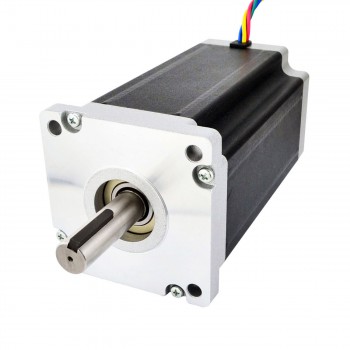A stepper motor is a special type of
brushless DC motor. Electromagnetic
coils are arranged around the outside of the motor. The center of the motor
contains an iron or magnetic core attached to a shaft. By sequencing the
voltage of the coils precise rotational control can be achieved at relatively
low cost. The drawback is, the control is generally open loop, so the system
does not know if the motor stalls or gets out of sync with the controller. How
do you know if your stepper motor is a unipolar or a bipolar stepper motor just
by looking at it? There are three main ways (yes, stepper motors do have a lot
of variation) that a stepper motor can be driven. These three driving styles
are full-step drive, half-step drive, and micro stepper motor for sale. Full-step drive always has two electromagnets (or at least two
different current flows) energized at the same time. In most cases, the motor
you are looking at is both. Unipolar and bipolar are just modes that you can
use to run the stepper motor.

The only time a stepper motor is not able to be
run in either mode is when there are only four wires coming out of the stepper
motor, corresponding to the both ends of the two coils and no central tap wire.
If you do have more than four wires, (whether five, six, or even eight wires)
at least one of those wires is a center tap wire. You can figure out which wire
is which by either looking up the datasheet for your motor or measuring the resistance
between two wires at a time with a multi-meter. If one particular wire always
measures half of the resistance that other pairs of wires report, then you know
that wire must be tapped in the middle (hence half the resistance) of a coil. Despite all of this information, we haven’t
actually learned how we can run our motors. To rotate the central shaft, one of
the current flows is shut off, “turning off” the electromagnet, and a different
current flow is started “turning on” another electromagnet. This driving style
has the most torque because two electromagnets are always energized but also
has the largest step size. The
half-step drive is similar to the full-step drive, but switches between having
one or two electromagnets energized.
One electromagnet will start out energized
and then a second one will be “turned on”. Next, the first electromagnet will
be “turned off” while leaving the second electromagnet energized. A new current
flow will then be started to energize the “third” electromagnet in addition to
the second electromagnet being “turned on”. This driving style results in half
of the step size of the full-step drive, allowing for more precision, but also
results in less torque because there are not always two electromagnets that are
energized. Microstepping, such as the
nema 42 stepper motors for sale that must have a stronger power than nema 8 stepper motor for sale that you
probably suspect, has the smallest step size out of these driving styles.

The
way it works is by applying a variable amount of voltage to each of the coils
in a sinusoidal fashion. The smaller voltage (and thus current flow) increments
you are able to produce, the smaller the step size. However, this also results
in a variable amount of torque that the stepper motor exhibits, depending on
where you are in the step sequence. Most drivers have a thermal protection feature that disables the driver
for a brief period of time to allow it to cool.
If you are loosing steps or hear a ticking or pulsing sound from your
motors, it could be due to thermal shutdown.



Really, this is an impressive as well as Useful post for me. I got the most valuable and informative information from here. Thanks for sharing, I request you to keep sharing such blogs. Permanent magnets
ReplyDelete